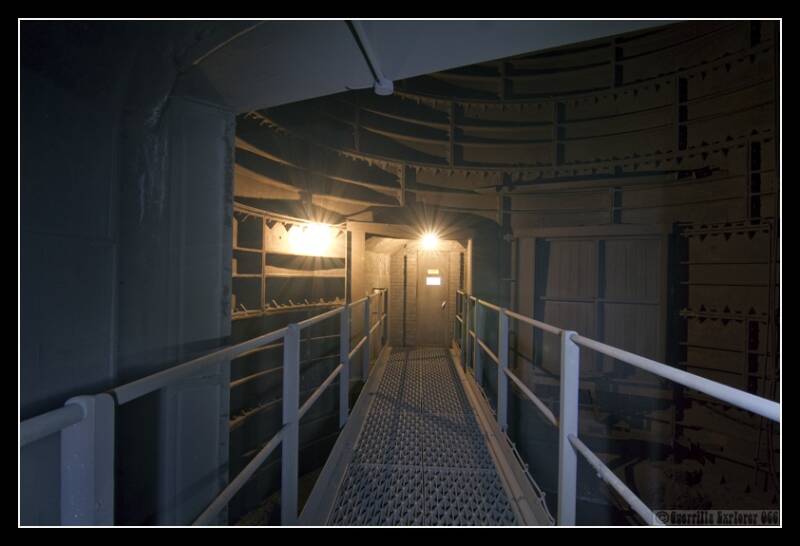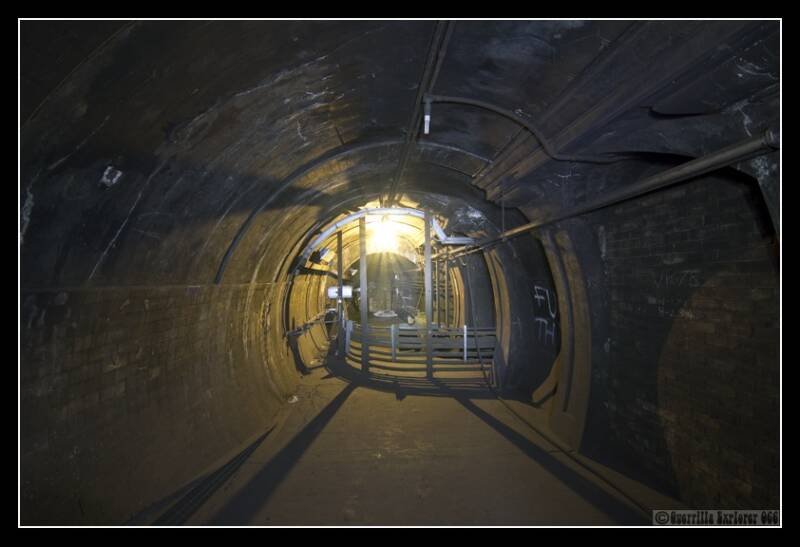GES214 - Euston Disused CCE&HR Underground Station
The Charing Cross, Euston and Hampstead Railway (CCEHR) opened their station in June 1907, next to the mainline Euston rail station. It was built across from the City and South London Railway (C& SLR) station, which opened a month earlier. A deep level passenger tunnel connected the two stations, with a ticket office in-between. The red terracotta glazed tiles give the place away as a Leslie Green building. With an entrance within Euston mainline station as well, it was quickly realised that three entrances weren't needed, and the CCE&HR and C&SLR) stations were closed. The later being demolished, the former used as a sub station and ventilation shaft. Below is an original picture of the station when open.

Now closed, the right hand side entrance leads into a open section filled with various cabinets that make up the substation. This substation would be our route in on numerous occasions. Sadly the building has been demolished for the rather pointless HS2 Fast train scheme. So I will reveal (dun dun duuuuuuuuuh!!) how we got in. Access details are usually something I keep secret or fake to keep the real access live for re-visits or friends.
I had a collapsible ladder, that wasn't the easiest of things to whizz around on the Vespa scooter I did most of my exploring on. We used 'urban camo' (basically hi-vis and helmets, because no one notices or questions you) and set about putting the ladder up to the sub-station roof. Kev then went up the ladder to look for ways in. I stood at the bottom of the ladder, as if I were footing it for him as a good worker. Opposite me was a restaurant, with people dining away. I can't lie that I was nervous, and worried about having to do a runner and leave my useful ladder. The scariest moment was when 2 BTP (British Transport Police) officers walked towards me from the BTP station in Euston. I crapped myself, and tried not to notice or show emotion. They walked straight past me chatting between themselves. Damn this camo is good! Breathing a sigh of relief, I was wondering what Kev was up to.
10mins later, Kev was still not back. However, the BTP officers were back, and walking towards me to get back to the station. I thought this would be it. However, again, they walked straight past me, carrying little blue bags of some kind of takeaway! They were clearly more interested in their food than two people up to no good with a ladder against one of the buildings there were supposed to protect.
Kev finally popped up, and said he had found a way in. So I climbed the ladder up, and then pulled the ladder up behind me. He had found an vent panel, that could be removed easily. We both slipped through, and were inside the sub-station. This had me on edge, as I envisaged bolts of electricity firing everywhere. We looked around, and there didn't appear to be a way into the station building. We then resorted to pulling up one of the many floor boards which had rings to pull them up. Underneath was a crawl space, and lots of scary high voltage cables.
Again, I was terrified, but Kev wasn't and in a flash was down and crawling around. "I've found a way in!" Kev excitedly shouted back in with his soft Polish accent. I dropped down, and crawled through the horrible grimy crawl space thick with tubedust. He showed me a hole in the side of the wall, and proceeded to climb through it. I got myself into position, and began to climb through, but my hips weren't going to do it. Kev was about 30cms shorter than me and somehow, skinnier. He told me to wait, while he went off to explore for options for Captain Wide Hips, to get in. He came back a few mins later, and said to go to a red door on the roof. He was able to open it from the inside. So I went back to the roof, and found the door, which a smiling Kev sat with it open. We were in!!
The crawl space, with Kev climbing through. Tube exploring isn't all glamour!

The entrance on the left-hand side leads into the area in the picture below (through red doors), with a ventilation funnel taking up most of the space.

Turning 180 degrees from the above picture, and walking through an opening, brings one into an open vent shaft. It sits in the corner of the building nearest the camera in the black and white picture above. The metal stairs on the left lead into a number of gantries (just visible on the right over the railings), that lead down to the deep level of the station.

The gantries with ladders leading down from the shaft seen above. It's difficult to see, but there's a tunnel leading off to the left below, that offers a glimpse of the Northern Line platforms, and the driver in his cab when a train pulls in.

Looking over at the passageway where the above shot was taken.

Dropping down the ladder in the above shot, and as mentioned above, a short tunnel leads out from the bottom of the vent shaft, and has grills that lead on to the tracks. The tunnel ends on the right where it's dark. The brief colourful ellipse, is the colours from the Northern Line platform. When a train stops in the station, looking through the right vent will mean looking into the trains cab of a Southbound train. It's believed that the tunnel was a test bore for a Deep Level Station that was proposed to be built here during WWII.

Walking out of the vent we had a left and right option in the passage. Going right leads to an old stairwell. On the left wall, a grey door leads into another vent shaft, that leads up to the funnel seen at the top of the page.

The back of the grey door mentioned in the above picture. Here is the vent that leads up to the funnel, a bridge leads across to the back side of the passageways. There was a lot of draft in here, and opening the grey door took a lot of strength, due to the pressure differences. When the station was still in use, this was a lift shaft, as was the one we descended from the surface.

With the shaft above on the left of the camera, these are the former lift entrance/exits. The passage leads off towards the lights and then a right angle to the right, which goes down to platform 1 (Northbound).

The filth encrusted subway passage, the steps to the platforms are on the right of the camera, the lift shafts are at the far end. A station identifier sits on the floor.

Steps down to the platform, that the passengers would have originally used. Now a mesh door blocks off the platforms.

Going back to the lift vent, and crossing the bridge, pulling open the grey door, we were back out in the first passageway we came across. We then went to the former stairwell, as seen here. The wall tiling leads up in a spiral pattern, originally there would have been stairs here.

Walking through the lift shaft, one comes to a passageway that leads towards the camera in the pic below.

Turning 90 degrees to the right from the above pic, leads to this hastily walled up area. This would have originally lead to the back entrances to the lifts seen above, and then down to the platforms.

Back by the grey door from earlier, and looking to the way out of the shaft we descended on the right. This passageway leads down to some steep steps. Behind the camera is the emergency stairs shaft.

Looking down to the lower level of the subway. This wouldn't have been a public area. To the right of the camera is a passageway that leads down to the other platform.

The original passenger stairs down to Platform 2 (Southbound). A mesh gate blocks platform access, but looking through the tiny gaps, you can see the platform and passengers.

Looking up the steep stairs to the lifts level.

Turning 180 degrees from the previous shot, A vent at the back looks down on some Victoria Line tracks. The vent in the foreground contains a ladder down to a tunnel.

The tunnel leading to a door at the far end, just out of site. It leads into the live station. Behind the camera was a cheap wooden partition. Kev popped over for a look, the tunnel was full of debris and waste. After about 20m, it opened out onto the Victoria Line. A flash of light showed that trains were certainly using it.

Add comment
Comments